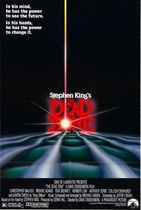Our editor-in-chief Nate Yapp is proud to have contributed to the new book Hidden Horror: A Celebration of 101 Underrated and Overlooked Fright Flicks, edited by Aaron Christensen. Another contributors include Anthony Timpone, B.J. Colangelo, Dave Alexander, Classic-Horror.com's own Robert C. Ring and John W. Bowen. Pick up a copy today from Amazon.com!
Terence Fisher
When one lists off the major horror directors (Whale, Romero, Craven, Cronenberg, etc.), it's easy to overlook Terence Fisher. After all, the man wasn't very outspoken and his contributions to the genre are often more recognized for the producing studio and the stars, rather than the force behind the camera. Nevertheless, Terence Fisher almost single-handedly reformed the British horror picture into a new entity of terror.
Not much is known about Fisher's early life. It is known that he was born in London circa 1904. He was a member of the merchant marine for a time as a teenager, but that life obviously did not suit him, as he left after five years. He did other, more land-based jobs, including becoming a partner in a rag trade.
Fisher broke into films in 1933, the hard way. He was a clapper boy on Falling for You, a musical comedy. He shifted up the ranks of British cinema with some amount of speed, going from that first menial job to third assistant director, then assistant editor, and, inevitably, editor in full. He worked mainly on Will Hay comedies (like Windbag the Sailor) and low-budget programmers.
The next logical step for the now 43-year-old man was helming his own film. He took a course in directing at Highbury Studios, and put his training to work in 1948's Colonel Bogey, a supernatural comedy. He followed that with a number of different films in different genres. Fisher has said that, of these early films, he is proudest of To the Public Danger (a 1948 morality film about alcohol excess).
In 1952, at the age of 48, Fisher joined Hammer Films and toiled on two relatively minor science fiction pictures, The Four-Sided Triangle (which he also co-wrote) and Spaceways. He worked on a bunch of unmemorable thrillers and comedies until 1957, when his career took a turn for the remarkable.
The film was Curse of Frankenstein, Hammer's first color production. Fisher's attachment to to it was purely legal: Hammer contractually owed him another directing job, and this was what the studio had planned next. What Fisher did with the film was anything but business - it was brilliance.
Although credit is due to screenwriter Jimmy Sangster for shifting the story from being creation-centric to a deeper look at the creator, it is Fisher who did the movie a greater service in what he refused to do. The Hammer honchos, particularly Sir James Carreras, were keen to have a film that hewed as closely to James Whale's 1931 classic as closely as legally possible, but Fisher declined the opportunity to even watch the older flick. He saw an opportunity for creating something radical and fresh, and he seized it. Thus was born the legendary Hammer Style.
Curse of Frankenstein was a smash hit, making stars of leading actors Christopher Lee and Peter Cushing, and holding the record (at that time, and for some time after) for Britain's highest grossing domestic film. Hammer saw that they had lightning in a bottle, and over the course of the next five years, Fisher turned out 8 adaptations/remakes, including Horror of Dracula, Hound of the Baskervilles, and The Mummy (all three with Cushing and Lee). He also filmed a sequel to Curse (1958's Revenge of Frankenstein) and a follow-up to Horror (1960's Brides of Dracula).
However, the last of that series of adaptations, 1962's Phantom of the Opera, proved to be a disaster. Though modern critics consider it to be among Fisher's best work, it was ill-received at the time by reviewers and audiences alike. Hammer's love affair with the director ended. The river of films slowed to a tiny stream, as the studio began to turn their attentions to Don Sharp, Roy Ward Baker, and Freddie Francis.
Fisher did nothing in 1963, after 5 years of working non-stop. In 1964, he helmed a few rather unnotable films (although The Gorgon had some interesting ideas and reteamed Cushing and Lee). He was brought back in 1965 to do a proper sequel to Horror of Dracula: Dracula - Prince of Darkness. He followed this with the last films of Hammer's Frankenstein cycle -- Frankenstein Created Woman, Frankenstein Must Be Destroyed, and Frankenstein and the Monster from Hell.
In 1968, between Woman and Destroyed, Fisher lensed The Devil Rides Out, one of many influential horror films from that year. While the general feel of the direction had much in common with Fisher's earlier work, the tone was astonishingly mature. It was an intelligent, thoughtful horror film - a rarity at the time. With Rosemary's Baby, this film opened the door for more adult horror fare.
Unfortunately, a fondness for alcohol left the director uninsurable. No studio would hire on a director with such a risk attached, and Fisher found himself without a career after Monster from Hell. He died of a heart attack in 1980 at the age of 76.








